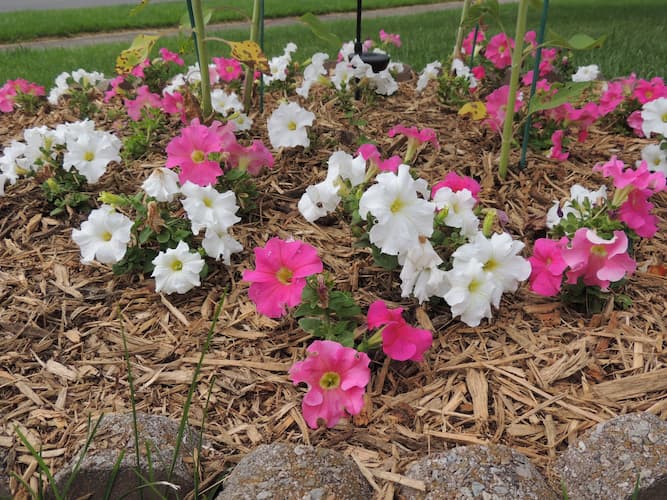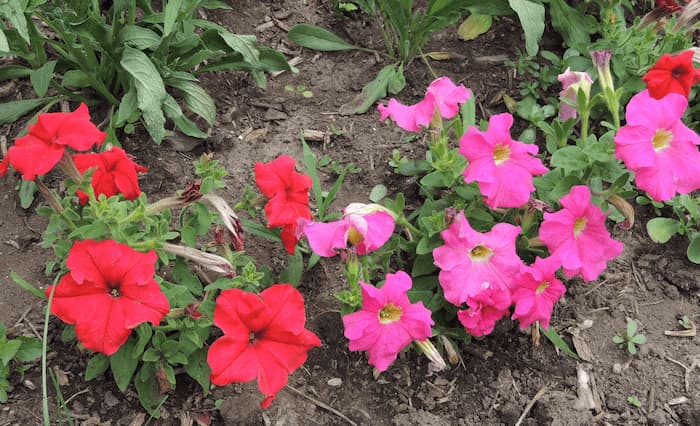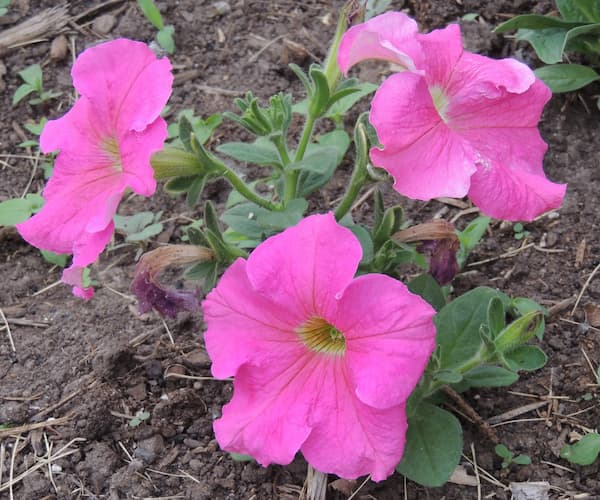How to Grow and Care for Petunia Flowers

About Growing Petunias in Your Home Flower Garden
We usually think of Petunia plants as annuals. Actually, most of them are tender perennials. Most of us, just happen to grow them as annuals, especially up north. Gardners and homeowners love growing petunias for their bright and cheerful blooms. And, the flowers keep coming and coming. They are native to Argentina, Brazil, and other parts of South America. Attractive petunia flowers caught the eye of early explorers, who collected seeds to take back to Europe and North America.
Petunias grow 12-15 inches tall. The Petunia plant and stem are covered with soft hair. Bright and colorful funnel-shaped flowers begin to bloom as early as late spring. Flower blooms are produced in many single and multi-colors.
Petunias are popular, easy, and fun to grow. Fill an area or entire bed with Petunias. They also are great in windowsills, containers, or even hanging baskets.
Did You Know? Petunias are used as an insecticide. Use it as a Companion Plant. And, you can use it to make an insecticidal spray.
Annual Petunia Flowers Plant Specifications
Flower Colors: includes a wide range of colors and bi-colors.
Flowers Bloom: Summer to Frost.
Plant Height: Twelve to fifteen inches.
Ideal Soil pH: 6.0 – 7.5.
Hardiness Zones: 9 – 11
Light Requirements: Bright, full sunlight.
Is the Plant Toxic? No
Deer Resistant? No. Deer, rabbits, and other foraging wild animals will eat the plants.
Number of Species: 35
Native To: South America
Plant Type: Annuals and Perennials.
Botanical Name: Petunia
Are Petunia Flowers Edible
Petunia plants are not considered edible. First of all, they don’t taste good. Second, they have little nutritional value. And, they can cause mild stomach upset.
Medicinal Uses for Petunia Plants
There are a variety of medical uses for Petunia plants. It contains antifungal and antibacterial properties.
Here are some of the medicinal applications:
- Use is to treat acne, dry and cracked skin, eczema, and other skin conditions.
- It is a relaxant to relieve anxiety and stress.
- Treats depression.
- It eases colds and coughs,
- Use it as a pain reliever for headaches.
Light Requirements
Petunias grow best in bright, direct sunlight. Plant them in a location where they will receive six to eight hours or more of direct sunlight.
In hotter regions, plant them where they receive partial shade on hot and sunny afternoons.
Too little sunlight can result in fewer and smaller flowers.

Annual Petunias Plant Propagation
Petunias are grown from seeds. Petunia seeds can be directly seeded into your flower garden or seeded indoors for transplanting later. For spring blooms, start your Petunias in pots and containers indoors six to eight weeks before the last frost. The seedlings will transplant well into their permanent home.
Sow Petunia seeds early in the season and cover lightly with 1/8″ of fine garden or potting soil. Water thoroughly once. They germinate slowly.
Note: We highly recommend a heated germination mat, to increase the speed of germination. And, it, results in a higher germination rate.
Transplant Petunias into your garden after the last frost date for your area.
If you are creating a flower bed, you may want to create a pattern or color scheme before planting. Or, use mixed varieties.
Final Plant Spacing: Space the plants 10 – 12 inches apart. They will tolerate a little crowding. And, they look great when grown en masse.
Days to Germination: 10 – 21 days.
How to Grow Petunia Flower Plants
Once your Petunia plants are established, they should grow well with few problems.
Where to plant Petunias:
Annual Petunia flowers like full sun. They prefer rich, loose soil that drains well. But, they tolerate poorer soils.
Fertilizer:
Add a general-purpose fertilizer when planting them, then once a month after that.
Water Needs:
Keep the soil moist to slightly dry. Water them during dry periods, once or twice per week. Do not allow the soil to remain soggy for extended periods. Make sure there is proper drainage.
Weeding:
Keep the plants well weeded. And, apply a 2-3 inch layer of mulch for a tidy appearance.
Petunia plants are half-hardy annuals. They will often survive the first frost if it is light. They will not survive a hard frost or freeze. Perennial varieties of Petunias will emerge again in the spring, in southern areas of the country.

How to Grow Petunia Flowers in Containers and Flowerpots
Annual Petunias look absolutely awesome in containers and flowerpots. Locate them on a balcony, deck, patio, or just about anywhere. You can enjoy these cheerful bloomers in a Window box planter outside your window.
Like any container-grown plant, they need a little more care and attention. In addition to normal plant care, here’s how to grow Petunia flowers in containers:
- As previously mentioned, annual Petunias look great grown in masse and tolerate a little overcrowding. So, grow them in containers closer than recommended.
- Select a sunny to partly sunny location on your deck.
- It is important to have a drain hole in the container to allow excess water to drain from the pot.
- Keep an eye on the moisture level. Check the plants every few days, especially in extended periods of hot, dry weather.
- Keep the soil moist, but not wet. It is okay to let the top of the soil begin to dry between watering.
- When watering the plants, thoroughly wet the soil. Excess water will drain through the hole in the bottom of the flowerpot.
- Nutrients in a flowerpot are limited. So, use fertilizer spikes to feed the plants. Or, apply a light solution of liquid fertilizer once a month.

Pruning Petunia Plants
When the plants grow about three to four long, pinch back the growing tips. This creates a bushier, more attractive plant. And, more branches, mean more blooms. In mid-season as the stems get leggy, prune them back about halfway. the plant will reward you with many new stems and many more flowers.
Also, remove the occasional dead ar sickly leaves and stems as soon as you spot them. Use clean, sharp pruning shears.
Remove the blooms as soon as they die off. This promotes additional blooms. And, it extends the blooming period all summer long, and right up to the first killing frost. This will also keep the appearance neat and beautiful.
If you plan on harvesting seeds to grow new annual petunias, leave a couple of spent blooms on the plant.
More on deadhead spent flower blooms.
Insects and Plant Disease
Petunias seldom have problems with insects and disease. However, if insect or disease problems occur, treat early with organic or chemical insect repellents and fungicide.
Also, see: Plant Problems – Identify the causes and find the cures.
Related Articles
Also, people who read this article on how to grow annual petunias will like:
Petunia Flowers Picture Gallery
How to Grow Petunia Plants – by Garden Hobbies
Please support our site. Shop for:
- rmmatthews100@hotmail.com
- 585-721-6528
- Rochester, NY
©1999-2024 GardenersNet.Com, All Rights Reserved

